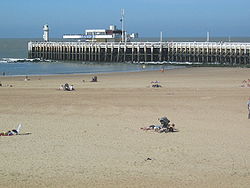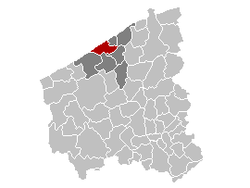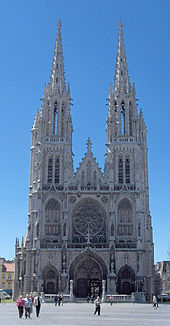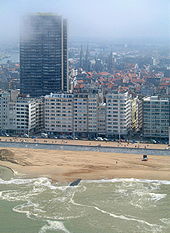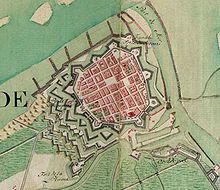- Ostend
-
For other uses, see Ostend (disambiguation).
Ostend
Oostende (Dutch)The beach at the pier. 
Flag
Coat of armsLocation in Belgium Coordinates: 51°14′N 02°55′E / 51.233°N 2.917°E Country Belgium Region Flemish Region Community Flemish Community Province West Flanders Arrondissement Ostend Government - Mayor Jean Vandecasteele (SP.A) - Governing party/ies SP.A, CD&V, VLD Area - Total 37.72 km2 (14.6 sq mi) Population (1 January 2010)[1] - Total 69,064 - Density 1,831/km2 (4,742.2/sq mi) Demographics - Foreigners 3.95% (7 January 2005) Postal codes 8400 Area codes 059 Website www.oostende.be Ostend (Dutch: Oostende, Dutch pronunciation: [oˑsˈtɛndə]; French: Ostende; German: Ostende, German pronunciation: [ɔsˈtɛndə]) is a Belgian city and municipality located in the Flemish province of West Flanders. It comprises the boroughs of Mariakerke (West Flanders), Stene and Zandvoorde, and the city of Ostend proper – the largest on the Belgian coast.
Contents
History
Origin to Middle Ages
In earlier times, Ostend was nothing more than a small village built on the east-end (Dutch: oost-einde) of an island (originally called Testerep) between the North Sea and a beach lake. Although small, the village rose to the status of "town" around 1265 when the inhabitants were allowed to hold a market and to build a market hall.
The major source of income for the inhabitants was fishing. The North Sea coastline has always been rather unstable and in 1395 the inhabitants decided to build a new Ostend behind large dikes and further away from the always-threatening sea.
Fifteenth to eighteenth century
The strategic position on the North Sea coast had major advantages for Ostend as a harbour but also proved to be a source of trouble. The town was frequently taken, ravaged, ransacked and destroyed by conquering armies. The Dutch rebels, the Geuzen, took control of the town. The Siege of Ostend, 1601 to 1604, of which it was said that "the Spanish assailed the unassailable and the Dutch defended the indefensible", cost a combined total of more than 80,000 dead or wounded, making it the single bloodiest battle of the Eighty Years' War. This shocking event set in motion negotiations that led to a truce several years later. When the truce broke down, it became a Dunkirker base.
After this era, Ostend was turned into a harbour of some importance. In 1722, the Dutch again closed off the entrance to the harbour of Antwerp, the Westerschelde. Therefore, Ostend rose in importance because the town provided an alternative exit to the sea. The Southern Netherlands (largely the territory of present Belgium) had become part of the Austrian Empire. The Austrian Emperor Charles VI granted the town the trade monopoly with Africa and the Far-East. The Oostendse Compagnie (the "Ostend trade company") was allowed to found colonies overseas. However, in 1727 the Oostendse Compagnie was forced to stop its activities because of Dutch and British pressure. The Netherlands and Britain would not allow competitors on the international trade level. Both nations regarded international trade as their privilege.
Modern era
In later times, the harbour of Ostend continued to expand because the harbour dock, as well as the traffic connections with the hinterland, were improved. In 1838, a railway connection with Brussels was constructed. Ostend became a transit harbour to England in 1846 when the first ferry sailed to Dover. It no longer serves the Dover route, but now has passenger and freight connections with Ramsgate. Very important for the image of the town was the attention it started to receive from the Belgian kings Leopold I and Leopold II. Both liked to spend their holidays in Ostend. Important monuments and villas were built to please the Royal Family. The rest of aristocratic Belgium followed and soon Ostend became known as "The Queen of the Belgian sea-side resorts".
In 1866 Ostend was the venue for a crucial meeting of exile Spanish Liberals and Republicans which laid the framework for a major uprising in their country, culminating in Spain's Glorious Revolution two years later.
The town hosted all but one of the sailing events for the 1920 Summer Olympics in neighbouring Antwerp.[2] They also hosted the polo events.[3]
Sights
- Interesting locations are the Casino and Fort Napoleon.
- Ostend is also famous for its sea-side esplanade, pier, and fine-sand beaches.
- The James Ensor museum can be visited in the house where the artist lived from 1917 until 1949.
- The Mercator, the ex training sailing ship for Belgian merchant navy officers, is now open to the public to view.
- Hippodrome Wellington, horse racing venue.
- St Petrus and St Paulus Church, Ostend (Sint-Petrus-en-Pauluskerk), built in Neo Gothic style.
- In the Mu.Zee (a new museum after the fusion of the Provinciaal Museum voor de Moderne Kunst-Aan-Zee and the "Museum voor Schone Kunsten"), the museum of modern art from the 1830s to the present, you can view works of noted local painters such as James Ensor, Leon Spilliaert, Constant Permeke and the revolutionary post-war Belgian COBRA movement amongst others.
- Beach(es): Ostend is visited by many 'day' tourists, especially during July and August. Tourists from the Belgian inland and foreigners mostly arrive by train (day trips) and head for the closest beach area from the station (kleinstrand). The locals and other residents in Belgium usually occupy the larger beach (grootstrand). Ostend used to be widely visited by British, Germans, French and Dutch, but is now mainly frequented by Belgians and Dutch.
- Near the beach is a well-preserved section of the World War II Atlantic Wall.
- Views from the pier promenade or beach of departing and arriving passenger ferry ships from Ramsgate (UK).
- During summer evenings (or just any kind of weather) you can walk through the little streets around Het Vissersplein. At certain times there are local markets in the neighbourhood streets and in the summer the Vissersplein has music festivals. The Vissersplein (Bonenstraat/Kadzandstraat) is a car free zone with many brasseries where you can sit outside and have a drink. Look towards the port side and find many little fish outlets, and beyond that, again, you can view close the ferries docking.
- Train station.
- Film locations: more and more directors are filming in Ostend.
The movies Place Vendôme with Catherine Deneuve; Daughters of Darkness[4] with Delphine Seyrig as Countess Bathory; Armaguedon[5] with Alain Delon; Camping Cosmos with Lolo Ferrari; and Ex Drummer based on the novel by Herman Brusselmans were partially shot in Ostend. - The comic Le Bal du rat mort[6] about a dreadful invasion of rats, is set in Ostend.
Climate
Climate data for Ostend Month Jan Feb Mar Apr May Jun Jul Aug Sep Oct Nov Dec Year Average high °C (°F) 6.1
(43.0)6.5
(43.7)9.2
(48.6)11.4
(52.5)15.3
(59.5)17.7
(63.9)20.3
(68.5)20.9
(69.6)18.3
(64.9)14.5
(58.1)9.7
(49.5)7.1
(44.8)13.08
(55.55)Average low °C (°F) 1.1
(34.0)0.5
(32.9)2.3
(36.1)4.1
(39.4)7.9
(46.2)10.7
(51.3)12.8
(55.0)12.5
(54.5)10.2
(50.4)7.1
(44.8)4.0
(39.2)2.3
(36.1)6.29
(43.33)Precipitation mm (inches) 62.6
(2.465)44.5
(1.752)55.0
(2.165)45.5
(1.791)56.2
(2.213)66.7
(2.626)59.2
(2.331)57.3
(2.256)79.9
(3.146)78.1
(3.075)83.9
(3.303)73.2
(2.882)762.1
(30.004)Avg. precipitation days 13 9 11 10 10 10 8 8 11 11 13 13 127 Source: World Meteorological Organisation (UN)[7] Economy
Jetairfly has its headquarters in Ostend.[8] TAAG Angola Airlines's Ostend offices are on the grounds of Ostend Airport in Ostend.[9]
Gallery
Notable residents
References to these notable citizens of Ostend can be found here: Oostendse biografieën (in Dutch)
- Louise of Orléans, first queen of the Belgians
- Lilian Baels, princess
- Auguste Marie Francois Beernaert, Prime Minister of Belgium and Nobel Peace Prize recipient
- Alfred Belpaire, locomotive engineer
- Gerard Brackx, tourism
- Cesar De Paepe, syndicalist
- James Ensor, painter
- Etienne Elias, painter
- Marvin Gaye, singer
- Hubert Minnebo, sculptor
- Arno Hintjens, lead-singer of TC Matic
- Karel Jonckheere, writer
- Mimi Lamote (b. Ostend, 27 April 1964), businesswoman
- Stefaan Maene, backstroke swimmer
- Marie-José of Belgium, princess, then last queen of Italy
- August Michiels, sculpturer, painter, engraver
- Constant Permeke, expressionist painter
- Raoul Servais, filmmaker
- Gustaaf Sorel, painter
- Leon Spilliaert, painter
- Henri Storck, author, film-maker, and maker of documentaries
- Robert Triffin, economist
- Johan Vande Lanotte, politician
- Robert Van De Walle, judoka
- Bart van den Bossche, singer, actor, and radio/TV presenter
- Peter Van Heirseele, aka Herr Seele, cartoonist (Cowboy Henk), painter and performer
- Rudolf Vanmoerkerke
Sport clubs
- Hermes Volley Oostende (volleyball)
- K.V. Oostende (football)
- Telindus Oostende (basketball)
- Wellington Golf Oostende (Golf)
See also
References
- ^ Population per municipality on 1 January 2010 (XLS; 221 KB)
- ^ "1920 Summer Olympics sailing". Sports-reference.com. http://www.sports-reference.com/olympics/summer/1920/SAI/. Retrieved 2011-04-22.
- ^ "1920 Summer Olympics polo". Sports-reference.com. http://www.sports-reference.com/olympics/summer/1920/POL/mens-polo.html. Retrieved 2011-04-22.
- ^ Daughters of Darkness at the Internet Movie Database
- ^ "''Armaguedon'' at IMDB". French.imdb.com. 2009-05-01. http://french.imdb.com/title/tt0074153/combined. Retrieved 2011-04-22.
- ^ Le Bal du rat mort
- ^ "World Weather Information Service – Ostend". United Nations. http://www.worldweather.org/053/c00944.htm. Retrieved 19 January 2011.
- ^ "TUIfly Academy Brussels." Jetairfly. Retrieved on 23 October 2009.
- ^ "TAAG Offices." TAAG Angola Airlines. Retrieved on 23 January 2010.
External links
- Toerisme Oostende - English edition - extensive.
- Free photos of Ostend
- Ostend Airport - Official website of the international airport of Ostend.
- Ostend photo gallery
- Official website Port of Oostende
- Official website - Information available in Dutch and limited information available in French, English and German.
- Oostendse verhalen- Site about the Ostend dialect and culture with Ostend grammatical rules. (mainly in Dutch (nl) and Ostend dialect).
Belgian Coast Tram route Knokke-Heist (Knokke - Heist) - Zeebrugge - Blankenberge - Wenduine - De Haan - Bredene - Ostend - Raversijde - Middelkerke - Westende - Lombardsijde - Nieuwpoort - Oostduinkerke - Koksijde - De PanneBruges Beernem · Blankenberge · Bruges/Brugge · Damme · Jabbeke · Knokke-Heist · Oostkamp · Torhout · Zedelgem · Zuienkerke
Diksmuide Kortrijk Ostend Roeselare Tielt Veurne Ypres Heuvelland · Ieper/Ypres · Langemark-Poelkapelle · Mesen · Poperinge · Vleteren · Wervik · ZonnebekeVenues of the 1920 Summer Olympics Antwerp · Antwerp Zoo · Beerschot Tennis Club · Beverloo Camp · Brussels–Scheldt Maritime Canal · Buiten Y (Amsterdam) · Gardens de la Palace d'Egmont · Hoogboom Military Camp · Jules Ottenstadion (Ghent) · Nachtegalen Park · Olympisch Stadion · Ostend · Palais de Glace d'Anvers · Stade Joseph Marien (Brussels) · Stade Nautique d'Antwerp · Stadion Broodstraat · Vélodrome d'Anvers Zuremborg1900: Le Havre, Meulan-en-Yvelines • 1908: Solent, Southampton Water • 1912: Nynäshamn • 1920: Ostend, Buiten Y • 1924: Le Havre, Meulan-en-Yvelines • 1928: Buiten Y, Zuiderzee • 1932: Los Angeles Harbor • 1936: Kiel Bay • 1948: Torbay • 1952: Harmaja, Liuskasaari • 1956: Port Phillip • 1960: Gulf of Naples • 1964: Enoshima • 1968: Club de Yates • 1972: Bay of Kiel • 1976: Portsmouth Olympic Harbour • 1980: Olympic Regatta in Tallinn • 1984: Long Beach Shoreline Marina • 1988: Busan Yachting Center • 1992: Olympic Harbour • 1996: Wassaw Sound • 2000: Rushcutters Bay • 2004: Agios Kosmas Olympic Sailing Centre • 2008: Qingdao International Sailing Centre • 2012: Weymouth and Portland National Sailing Academy • 2016: Marina da Glória Categories:
Categories:- Ostend
- 1920 Summer Olympic venues
- Cities and towns in Flanders
- Municipalities of West Flanders
- Olympic sailing venues
- Populated coastal places in Belgium
- Populated places in Belgium
- Ports and harbours of the English Channel
- Port cities and towns in Belgium
- Port cities and towns of the North Sea
- Seaside resorts in Belgium
Wikimedia Foundation. 2010.

